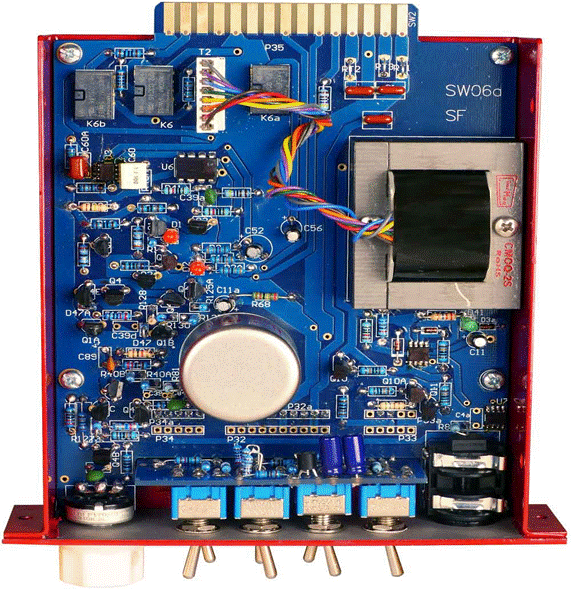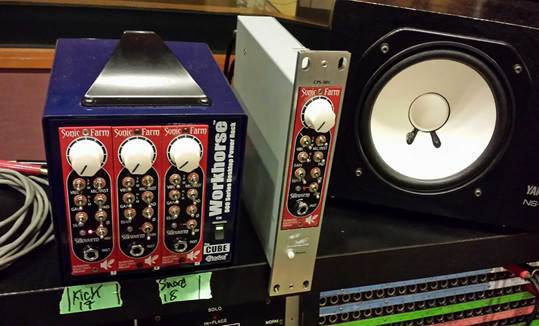We recommend three great 500 Series-compatible
microphone preamplifiers.
I honestly cannot get enough of the 500 Series gear. Between
my two facilities, I have a 10-slot API 500V chassis, an API Lunchbox and a
Tonelux V4 Roadster and I’m already evaluating my best option to increase my
500 Series module capacity. The modular format makes it simple to swap pieces
between studios or easily record in a remote location. Trying out a new piece
of gear or substituting a few unique pieces for a tracking session doesn’t
require any additional cabling or installation headaches. The for-mat’s low
supply voltage, limited maximum current draw and size restrictions do pose some
significant design challenges, but manufacturers have overcome these issues as
evidenced by the plethora of quality options out there.
The biggest challenge for most 500 Series users is keeping
track of which modules are the cream of the crop. I’ve had the chance to log
some serious time with several great pieces over the past few months and I’m
going to use the next few issues of PARto share my findings. Here I’ll discuss
three fantastic mic pre-amps: the Sonic Farm Silkworm ($700), the Electrodyne
501 ($1,000) and the Heider FD312 ($750). I will also report on MXL’s latest
tube mic offering, the higher-end Revelation Solo ($699).
Sonic Farm Silkworm
I became a huge fan of Sonic Farm Pro Audio after reviewing
the Creamer (PARMay 2012) and was thrilled to hear the company was entering the
500 Series market. Given the Creamer’s success, I expected the Silkworm to be a
variation of the same pre, but that’s not the case.

Silkworm series
500 preamp
The Silkworm is an entirely new beast and is simply
brilliant. The Silkworm’s gain is controlled by combining a three-position Gain
switch and a variable Gain Trim control. It’s switchable from Medium to Low to
High, which was a bit awkward at first; when I tried to raise the gain from low
to medium, my natural reflex was to turn the switch up a click, but this
actually raises it from low to high. The Silkworm incorporates a Cinemag input
transformer and provides a maximum gain of 66 dB (or 42 dB of instrument gain).
with a fully discrete gain stage and a full DC path with no coupling
capacitors. The maxi-mum output level is 28.7 dBu. As with the Creamer, the
output is switchable between solid-state balanced and transformer (Cinemag 100%
Fe). I found that I almost always preferred the transformer output, but there
were some instances (most often acoustic guitar and occasionally vocals) where
I preferred the solid-state output. While the Silkworm is not a clone of any
other mic pre, I’m still prone to describe it as very GML-esque in the solid-state
output mode and very Neveish in the transformer output mode. The Silkworm’s
real magic is in the Vibe switch, which completely changes the character of the
pre. The manual describes this feature as a complex impedance manipulator and
it includes three settings, Smooth, Present, and Warped (labeled S, P and W).
Present—the most neutral and natural sounding of the three—provides a flat 8 kΩ
input impedance while Smooth and Warped utilize a capacitive resistive network.
Smooth has a warmer top end and Warped has a top end boost, which seemed more
pronounced on dynamic microphones. In most cases, there was a substantial sonic
difference between the three settings; when recording with the pre, I would
dial in the entire signal path and then switch between the three modes and
decide which one I liked best. Each option sounded like an entirely different
mic pre and my preference was different nearly every time.

Silkworm_inside
The Silkworm works wonders on drums. I only had a single
unit for my review but I’d kill for a dozen channels to use on an entire drum
kit during a full tracking session. On multiple tracking sessions, I used the
pre along with a Telefunken M80, Heil PR20 and Shure SM57 to record snare drum;
I had fantastic results in each instance. I’ve been utilizing Auralex’s
Trap-Xpander to decrease hi-hat bleed into the snare mic and found that it
works exceptionally well for that. I also had fantastic results utilizing the
pre on kick drum, toms and hi-hat. The Silkworm works equally well recording
electric guitars, vocals and acoustic instruments. I’ve used it for all of
these over the past several months and my results have always been positive; in
every instance, I enjoy auditioning the Vibe set-ting after getting the sound
“roughed in.” Its direct input sounds sick on bass; tone is punchy, present and
full, while the bottom is thick and defined.

The Silkworm works
equally well recording electric guitars, vocals and acoustic instruments
|
Specifications
·
Fully discrete gain stage
·
Full DC path, no coupling capacitors
·
Servo control for minimal DC offset
·
Maximum gain 66dB (mic) and 42dB (instrument)
·
Maximum output level: 28.7dBu
·
Cinemag input mic transformer
·
Cinemag 100% Fe output transformer
·
Switchable transformer or solid state balanced output
·
3-way character (vibe) switch
·
Gain regulation twofold: 3-pos range switch and trim control
·
Mic input impedance: variable (see manual)
·
Instrument input impedance: 2.2MOhm
·
Website: sonicfarm.com
|